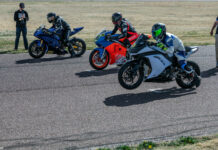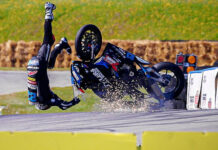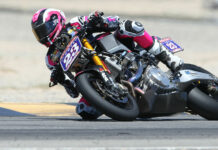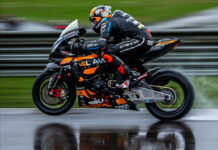TRACK FACTS – SACHSENRING One of the great centres of grand prix motorcycle racing that moved with the times to construct a short purpose built circuit that ensured the future of the German Grand Prix. The whole area around the Sachsenring is steeped in grand prix tradition with the famous 8.731km road circuit staging the East German Grand Prix in front of massive crowds between 1961 and 1972. Like many before, the road circuit was deemed too dangerous to stage grand prix racing depriving the community of a rare glimpse of western culture but when Germany became a united nation, plans to build a short circuit to stage the German Grand Prix were put in place. The first grand prix on the new circuit was in 1998 and won by World Champion Mick Doohan riding the Honda. The track was lengthened to its present day 3.671km configuration in 2003. It is the shortest track in the 17 round MotoGP calendar but only the third slowest and usually provides very close racing. Last year Max Biaggi won the race which he started from pole position, riding the Camel Honda with Makoto Tamada in sixth place. Alex Barros won the 500cc race in 2000 riding for Honda Pons and finished second behind Biaggi last year. His team-mate Troy Bayliss made a spectacular debut at the circuit in 2003 when he finished third behind Sete Gibernau and Valentino Rossi, riding the Ducati FROM THE SADDLE Alex Barros: “I’m happy to be heading to Sachsenring, where we are all hoping for a nice sunny day for the race! It is an unusual track; tight and twisty, but I like it because I’ve had some good results there both on the 500cc bikes and on the MotoGP bike. Last year I battled for victory with Max and I think I did one of the best races of the year, so I’m quite confident for Sunday. The podium in Donington was really satisfying beause the conditions were truly awful, but in Sachsenring I want to do even better before returning to Brazil for the summer break.” Troy Bayliss: “I was really annoyed at Donington, even though there’s nobody to blame for what happened considering the rotten conditions in the race. I returned home to Monaco, and took out my anger with a good bike ride and now I’m ready to race again. I love Sachsenring, I can’t wait to race there next Sunday. I feel so much more comfortable with the bike, we’ve made some steps forward with the settings and if we continue in this fashion, I will have my say on Sunday.” CIRCUIT – GERMAN GRAND PRIX – 31/07/05 SACHSENRING Track data: Length: 3.671 km Pole Position: Left Width: 10m Right corners: Four Left corners: Ten Longest straight: 780m Constructed: March 1996 Modified: 2003 Lap record: Alex Barros (Honda) 1:24.056 – 157.224 mph Pole record: Max Biaggi(Camel Honda) 1:22.756 – 155.694 mph Race winner 2004: Max Biaggi (Camel Honda) 42:23.287 – 155.888 km/h Alex Barros/Troy Bayliss 2004 Alex Barros: second Troy Bayliss: DNF TECHNICAL INSIGHT – GERMAN GRAND PRIX – 31/07/05 SACHSENRING The Sachsenring circuit is tight and twisty. It is, at 3671 metres, the shortest in the World Championship. However, surprisingly perhaps, the race distance is also the shortest of the season at 110.13 kms in MotoGP compared to the average which is around 120 kms. The explanation of the short distance is that the average lap speed is the third slowest of the championship at 157.828 Km/h, behind Cheste and Estoril, and therefore the number of laps to be completed is reduced. With only 110 km to cover, the race is run over 30 laps which makes the race seem never-ending to the riders and teams who are in the lead! Another characteristic of this circuit is its peculiar layout: the first section is tight and twisty and it is here where the bike must be very nimble in the changes of direction. In this section, which includes the first two intermediate time checks up to the exit of the Karthallen Corner, the average speed is less than 134 km/h. However, in the next section of the track leading up to the start/finish line, the average speed is over 177 Km/h and it is here where the bike speed through the corners is crucial in setting a good lap time. This is also the section of the circuit where we find pronounced undulations. With gradients of up to 13% on the down slopes and 10 % on the inclines, the Sachsenring Circuit, although short and twisty, is nevertheless a track where the power delivery of the engine is crucial in getting a good result. Another peculiarity about this track is the large difference between the number of left and right handed corners. Sachsenring, together with Phillip Island and Cheste, are the only three circuits in the World Championship where left handed corners outweigh right-handers. There are ten left handed corners and only four right handers. This factor has a significant influence on the compound of the tyres since they must be harder on the left side to withstand the accelerations in the Karthallen and Audi-Brucken corners, and relatively soft on the right side because there are relatively few right hand corners. Also the corner just before the downhill section leading into the Sachsenkurve is preceded by a series of seven continuous left hand corners which means that the right side of the tyre will be colder than normal and will lack grip, a situation which can cause a rider to crash out. Every year this corner is often the scene of frequent crashes where riders suffer physical injury because it’s taken at speeds of more than 200 Km/h. In the gear change set up, at a circuit where speeds are so slow and where first gear is not used, the gear change ratios must be set exactly, especially in second and fourth since these gears are used the most. It is a typical circuit where much discussion takes place about whether to use a five or six speed gear box. Normally the gears from second to sixth are used and first is only used at the start. This situation is repeated at other circuits, but at the Sachsenring second gear is very short and this makes first gear even shorter than would be normal for the race starts. Although on paper it seems that a shorter gear would permit a better start, in reality it is the other way around since the delivery of power is too sudden and causes wheelies and skidding as the bike leaves the starting grid. Sachsenring has a top speed of 270 Km/h which means the jumps between the gears are very short. This factor, together with the undulations, means that one of the main problems facing riders is trying to avoid wheelies in the main straight and in the first twisty section. This is a typical circuit where the control of power, whether it be by the rider or through electronics, is crucial in getting the maximum performance out of the bike.
Controlling The Power Delivery Is Key At Sachsenring
Controlling The Power Delivery Is Key At Sachsenring
© 2005, Roadracing World Publishing, Inc.






